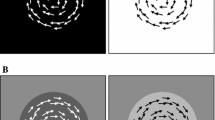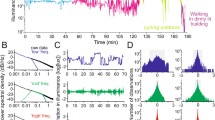Abstract
In mammals, the suprachiasmatic nucleus (SCN) is a pacemaker regulating daily rhythms. In birds, two retinorecipient nuclei have been called the avian SCN, one in the lateral hypothalamus and the other more medial and rostral. We asked whether the protooncogene c-fos is expressed in either nucleus after light exposure during subjective night, but not during subjective day, as is the case in the SCN of mammals.
Chicks raised with one eye covered by a diffuser were exposed to vertically moving surroundings, after the difuser had been switched to the other eye.
Surprisingly, we saw strong Fos label only in the lateral nucleus contralateral to the eye newly exposed to visual motion, but not in the ipsilateral nucleus nor in either medial SCN. No label was seen in animals kept in darkness or if the diffuser was not switched. Fos labeling did not differ between subjective day and night. The sensitivity to “novel” motion is also seen in motion-processing nuclei of the accessory optic system and pretectum; this suggests either that the lateral SCN is not the SCN, but part of the motion pathway, or that the avian SCN may be motion-sensitive during both day and night.
Similar content being viewed by others
References
Aronin N, Schwartz WJ (1991) A new strategy to explore molecular mechanisms of suprachiasmatic nucleus function. In: Klein DC, Moore RY, Reppert SM (eds) The suprachiasmatic nucleus: The mind's clock. Oxford Univ Press, New York, pp 445–456
Bos NP, Mirmiran M (1990) Circadian rhythms in spontaneous neuronal discharges of the cultured suprachiasmatic nucleus. Brain Res 511:158–162
Buelow NF, Kelly ME, Uchiyama H, Barlow RB (1991) Circadian clock modulates the rod-cone shift in quail. Invest Ophthalmol (ARVO Suppl) 32:903
Burns S, Wallman J (1981) Relation of single unit properties to the oculomotor function of the nucleus of the basal optic root (accessory optic system) in chickens. Exp Brain Res 42:171–180
Card JP, Moore RY (1984) The suprachiasmatic nucleus of the golden hamster: immunohistochemical analysis of cell and fiber distribution. Neuroscience 13:415–31
Cassone VM (1988) Circadian variation of [14C] 2-deoxyglucose uptake within the suprachiasmatic nucleus of the house sparrow, Passer domesticus. Brain Res 459:178–182
Cassone VM, Brooks DS (1991) Sites of melatonin action in the brain of the house sparrow, Passer domesticus. J Exp Zool 260:302–309
Cassone VM, Moore RY (1987) Retinohypothalamic projection and suprachiasmatic nucleus of the house sparrow, Passer domesticus. J Comp Neurol 266:171–182
Chambille I, Doyle S, Servière J (1993) Photic induction and circadian expression of Fos-like protein: immunohistochemical study in the retina and suprachiasmatic nuclei of hamster. Brain Res 612:138–150
Cooper ML, Pickard GE, Silver R (1983) Retinohypothalamic pathway in the dove demonstrated by anterograde HRP. Brain Res Bull 10:715–718
Dwyer MR, Meyer EL, Harrington ME, Bittman EL (1992) Induction of Fos in the suprachiasmatic nuclei in vitro. Soc Neurosci Abstr 18:1228
Ebihara S, Kawamura H (1981) The role of the pineal organ and the suprachiasmatic nucleus in the control of circadian locomotor rhythms in the Java sparrow, Padda oryzivora. J Comp Physiol 141:207–214
Ebihara S, Oshima I, Yamada H, Goto M, Sato K (1987) Circadian organization in the pigeon. In: Hiroshige T, Homma K (eds) Comparative aspects of circadian clocks. Hokkaido Univ Press, Sapporo, pp 88–94
Ehrlich D, Mark R (1984) An atlas of the primary visual projections in the brain of the chick Gallus gallus. J Comp Neurol 223:592–610
Ericson H, Blomqvist A (1988) Tracing of neuronal connections with cholera toxin subunit B: light and electron microscopic immunohistochemistry using monoclonal antibodies. J Neurosci Meth 24:225–235
Fitzgerald MEC, Reiner A (1990) Light-mediated reflexive control of choroidal blood flow in the pigeon. Soc Neurosci Abstr 16:1077
Gamlin PD, Reiner A (1991) The Edinger-Westphal nucleus: sources of input influencing accommodation, pupilloconstriction, and choroidal blood flow. J Comp Neurol 306:425–38
Gillette MU (1991) SCN electrophysiology in vitro: Rhythmic and endogenous clock properties. In: Klein DC, Moore RY, Reppert SM (eds) Suprachiasmatic nucleus: The mind's clock. Oxford Univ Press, New York, pp 125–143
Gioanni H, Rey J, Villalobos J, Dalbera A (1984) Single unit activity in the nucleus of the basal optic root (nBOR) during optokinetic, vestibular and visuo-vestibular stimulations in the alert pigeon (Columba livia). Exp Brain Res 57:49–60
Gioanni H, Palacios A, Sansonetti A, Varela F (1991) Role of the nucleus geniculatus lateralis ventralis (GLv) in the optokinetic reflex. A lesion study in the pigeon. Exp Brain Res 86:601–607
Hamassaki DE, Britto LRG (1990) Thalamic origin of neuropeptide Y innervation of the accessory optic nucleus of the pigeon (Columba livia). Visual Neurosci 5:249–260
Hartwig HG (1974) Electron microscopic evidence for a retinohypothalamic projection to the suprachiasmatic nucleus of Passer domesticus. Cell Tissue Res 153:89–99
Johnson RF, Moore RY, Morin LP (1988) Loss of entrainment and anatomical plasticity after lesions of the hamster retinohypothalamic tract. Brain Res 460:297–313
Jun L, Cassone VM (1992) Pineal regulation of circadian rhythms of 2[125I] iodomelatonin binding and 2-deoxy[14C]glucose uptake in the brain of the house sparrow, Passer domesticus. Soc Res Biol Rhythms, p 98
Kaufman CM, Shimomura K, Colwell CS, Menaker M (1992) GABAergic agents which prevent light-induced phase shifts of the circadian system do not inhibit the photic regulation of fos-like immunoreactivity in the hamster suprachiasmatic nucleus. Soc Neurosci Abstr 18:880
Kornhauser JM, Nelson DE, Mayo KE, Takahashi JS (1990) Photic and circadian regulation of c-fos expression in the hamster suprachiasmatic nucleus. Neuron 5:127–134
Kuenzel WJ, Massen M (1988) A stereotaxic atlas of the brain of the chick, Gallus domesticus. Johns Hopkins Univ Press, Baltimore, Maryland
McKenna OC, Wallman J (1985) Functional postnatal changes in avian brain regions responsive to retinal slip: a 2-deoxy-D-glucose study. J Neurosci 5:330–342
Meier RE (1973) Autoradiographic evidence for a direct retinohypothalamic projection in the avian brain. Brain Res 53:417–421
Menaker M (1969) Extraretinal light perception in the sparrow 1. Entrainment of the biological clock. Proc NY Acad Sci 59:414–421
Mosko S, Moore RY (1978) Neonatal suprachiasmatic nucleus ablation: absence of functional and morphological plasticity. Proc Natl Acad Sci USA 75:6243–6246
Norgren RB, Silver R (1989) Retinohypothalamic projections and the suprachiasmatic nucleus in birds. Brain Behav Evol 34:73–83
Norgren RB, Silver R (1990) Distribution of vasoactive peptide-like and neurophysin-like immunoreactive neurons and acetylcholinesterase staining in the ring dove hypothalamus with emphasis on the question of an avian suprachiasmatic nucleus. Cell Tissue Res 259:331–339
Panzica GC (1985) Vasotocin-immunoreactive elements and neuronal typology in the suprachiasmatic nucleus of the chicken and Japanese quail. Cell Tissue Res 242:371–376
Peczely P, Kiss JZ (1988) Immunoreactivity to vasoactive intestinal polypeptide (VIP) and thyreotropin-releasing hormone (TRH) in hypothalamic neurons of the domesticated pigeon (Columba livia). Alterations following lactation and exposure to cold. Cell Tissue Res 251:485–494
Remé CE, Wirz-Justice A, Terman M (1991) The visual input stage of the mammalian circadian pacemaking system: 1. J Biol Rhythms 6:5–29
Repérant J (1973) Nouvelles données sur les projections visuelles chez le pigeon (Columba livia). J Hirnforsch 14:151–187
Repérant J, Raffm JP (1974) Les projections visuelles chez le goeland argente (Larus argentatus argentatus, Pontopp) et le goeland brun (Larus fuscus greillsii, Brehm). C R Acad Sci Paris 278:2335–2338
Rojas X, Wallman J, Leah J (1990) c-fos expression in directionally selective visual system neurons. Soc Neurosci Abstr 16:847
Rose SPR (1991) How chicks make memories: the cellular cascade from c-fos to dendritic remodelling. Trends Neurosci 14:390–397
Schaeffel F, Rohrer B, Lemmer T, Zrenner E (1991) Diurnal control of rod function in the chicken. Visual Neurosci 6:641–653
Schwartz WJ (1991) SCN metabolic activity in vivo. In: Klein DC, Moore RY, Reppert SM (eds) Suprachiasmatic nucleus: The mind's clock. Oxford Univ Press, New York, pp 144–156
Shimizu T, Britto LRG, Karten HJ, Cox K (1991) Cholera toxin mapping of retinal projections in birds. Soc Neurosci Abstr 17:651
Shimuzu I, Yoshimoto M, Kojima T, Okadao N (1984) Development of retinohypothalamic projections in the chick embryo. Neurosci Lett 50:43–47
Simpson SM, Follet BK (1981) Pineal and hypothalamic pacemakers: their role in regulating circadian rhythmicity in Japanese quail. J Comp Physiol 144:381–389
Stephan FK, Zucker I (1972) Circadian rhythms in drinking behavior and locomotor activity of rats are eliminated by hypothalamic lesions. Proc Natl Acad Sci USA 69:1583–1586
Takahashi JS, Menaker M (1982) Role of the suprachiasmatic nuclei in the circadian system of the house sparrow, Passer domesticus. J Neurosci 2:815–828
Takahashi JS, Zatz M (1982) Regulation of circadian rhythmicity. Science 217:1104–1111
Takahashi J, Decoursy P, Bauman L, Menaker M (1984) Spectral sensitivity of a novel photoreceptor system mediating entrainment of mammalian circadian rhythms. Nature 308:186–188
Telford L, Frost BJ (1989) Functional activity in the accessory optic system during visual, vestibular and visual-vestibular stimulation in the pigeon. Exp Brain Res 77:391–397
Underwood H, Barrett RK, Siopes T (1990a) The quail's eye: a biological clock. J Biol Rhythms 5:257–265
Underwood H, Barrett RK, Siopes T (1990b) Melatonin does not link the eyes to the rest of the circadian system in quail: a neural pathway is involved. J Biol Rhythms 5:349–361
Van Tienhoven A, Planck RJ (1973) The effect of light on avian reproductive activity. In: Greep R, Astwood E, Geiger S (eds) Handbook of physiology, endocrinology II, part 1. Washington DC: Am Physiol Soc, pp 79–107
Wallman J, Ledoux C, Friedman MB (1978) Simple devices for restricting the visual fields of birds. Behav Res Meth Instrum 10:401–403
Wallman J, Teakle E, Silver R (1991) The putative suprachiasmatic nucleus of birds responds to visual motion. Soc Neurosci Abstr 17:24
Wilson BC, Summerlee AJS, Spurgeon JR (1990) Patterned light and entrainment of locomotor activity in mice. Soc Res Biol Rhythms, p 53
Yücel YH, Kim MS, Jardon B, Bonaventure N (1990) Abolition of monocular optokinetic nystagmus and directional asymmetry after unilateral visual deprivation in adult vertebrates: involvement of GABAergic mechanism. Dev Brain Res 53:179–185
Author information
Authors and Affiliations
Rights and permissions
About this article
Cite this article
Wallman, J., Saldanha, C.J. & Silver, R. A putative suprachiasmatic nucleus of birds responds to visual motion. J Comp Physiol A 174, 297–304 (1994). https://doi.org/10.1007/BF00240212
Accepted:
Issue Date:
DOI: https://doi.org/10.1007/BF00240212




